In Our Own Image
Published in 18th–19th - Century History, 20th-century / Contemporary History, Features, Issue 4 (Winter 1998), Volume 6
Just over a decade later, in 1917, the first issue of the Dublin Chamber of Commerce Year Book listed a total of 337 classes of goods manufactured in the city, ranging from account books to zinc goods and including artesian well-boring appliances, buoys, deformity apparatuses, feathers, gunpowder, hat racks, ladies’ corsets, magnesia, prayer books, river lighters, silver jewellery (Celtic), telescopes, vertical bar railings and whiskey. Among the brand names featured were Reducine, ‘the great remedy for lameness in horses’; Watkins, Jameson, Pim & Co.’s Shamrock Stout; Edward D. McCrea & Sons’ Bullet brand collars; Distillers’ Co.’s D.C.L. yeast and the Blackrock Hosiery Co.’s Rock underwear. But the majority of firms advertised under their own name: the advantage of a distinctive brand-name as an marketing tool was yet to be fully appreciated.
Irish brand names
The concept of giving a product or service an identity other than that of its manufacturer or vendor had, however, respectable antecedents in the Irish context. The introduction by the Irish parliament of stamp duties on newspapers in 1774 and their increase ten years later had had an inhibiting effect on trade, particularly in terms of product promotion in the public prints: they included a tax on advertising which was raised to the punitive level of one shilling (5p) per advertisement in 1784. Though these taxes were not fully repealed until the 1850s substantial undertakings such as the tobacco manufacturers had already begun to introduce brand names at point of sale—that is, on their packaging and showcards. The Belfast firm of Murray, Sons & Co. (1810) promoted Hall Mark, Pineapple and Special Crown cigarettes; Goodbody of Tullamore (1848) produced a wide range of named brands including Furze Blossom Navy Cut, Golden Flake, Light Brigade and Primrose; while Tom Gallagher, a Derry man who founded his firm in 1857, was rapidly successful with Honeydew tobaccos and Gold Plate, Golden Spangled, Day Star and Windfall cigarettes. The nomenclature, with few exceptions, involved no specific Irish identity, though Goodbody did venture into this field with Eblana Flake and Donore Castle cigarettes, while Murray was to achieve wide recognition for its Erinmore tobaccos.
On 14 May 1850 the Irish Manufacture and Industry Society was founded ‘by thirty gentlemen, of different religious persuasions, to devise ways and means of imparting practical industrial education to the great mass of the ignorant and neglected poor of Ireland of both sexes, and to revive industry and manufactures in the country’. The life-members included Alderman Benjamin Lee Guinness, third son of the second Arthur, whose eponymous brewery (1759) was twelve years later to register its long-lived trade mark label bearing the harp of Briain Boroimhe. The aims of this society, precursor of a century of ‘buy Irish’ bodies, awoke a sympathetic response in Richard Kelly, ‘Ladies’ and gentlemen’s Boot and Shoemaker’, of 16 College Green, Dublin, who in W.F. Wakeman’s Three Days on the Shannon (Dublin 1852) addressed ‘tourists, travellers, and ladies of Ireland’ as follows:
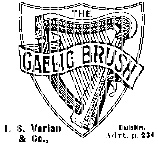
IT IS A FACT—That it is part of man’s nature to love the country in which he was born. This love of country, or patriotism, is a quality which, when true and sincere, is always admired and applauded wherever found. If we love our country we must cherish the desire of serving it. The conclusion is clear, that we, the natives of Ireland, are bound to serve Ireland if we can. IT IS A FACT—That there are 33,600 boxes of paste blacking used in Ireland weekly. IT IS A FACT—That the manufacture of it in Ireland would give employment to 144 box makers—each man to make 240 boxes weekly. IT IS A FACT—That it would give employment to forty-eight printers, printing small labels, cards etc. IT IS A FACT—That it would take 1,000 reams of paper for folding, printing, etc. weekly. IT IS A FACT—That it would employ 500 boys weekly, packing, folding, etc., with about fifty men for other purposes… Who then, after reading these undeniable FACTS, will not make it his or her special care to ask for Kelly’s Hibernian Blacking and Matches?
Waters of Eblana
‘Hibernian’ might not have been the most original brand name in the world, but the sentiments behind it suggested the evolution of a commercial response to the strengthening of political and cultural nationalism that characterised the latter decades of the nineteenth century. In the same publication Fred Lewis, ‘Perfumer and Refined Soap Maker’, of Fleet Street, Dublin, was advertising the claim that his Honey Toilet Soap was ‘superior to any other’; twenty-four years later,

in Charles Eason’s Almanac and Handbook for Ireland, he introduced a new perfume, Waters of Eblana, which, however, he felt constrained to gloss in the text as Waters of Dublin. About this time the young D.P. Moran, whose foundation of The Leader in 1900 was to play a major role in the promotion of ‘Irish Ireland’, was reading the satirical serial ‘Mick McQuaid’ which was to lend its name to a popular brand of Carroll’s tobacco. His seminal Philosophy of Irish Ireland appeared in 1905, on the heels of Douglas Hyde’s equally challenging essay The Necessity for de-Anglicising Ireland (1901). Carolls, for their part, responded in 1906 with their Emerald Gem cigarettes.
Not everyone, however, was an adherent of the Sinn Féin philosophy of self-sufficiency allied to a strongly Gaelic-Irish identity. The business community, as Moran consistently pointed out in The Leader, was dominated by Protestants, the majority holding unionist attitudes: it was scarcely likely that they would be moved by the doctrines of the Gaelic League, which Bernard Shaw in his 1904 preface to John Bull’s Other Island had mischievously described as ‘a quaint little offshoot of English pre-Raphaelitism’. It was not for politico-religious reasons, however, that P.J. Carroll opted for a Scottish identity for its Sweet Afton cigarettes (1919) complete with verbal and visual evocations of Robbie Burns. This was a rare and early example of a product aimed specifically at an export market, in which, Carrolls clearly believed, an Irish image would serve no commercial purpose.
Moran’s Leader also attacked the business community on other grounds, claiming that while the public was irrationally biased against Irish goods, the fault lay largely with the manufacturers who were failing to deliver value for money and in particular neglecting to employ modern publicity methods. Æ castigated them from a similar standpoint in The Irish Homestead (6 September 1913):
We doubt whether during the last fifty years any manufacturer has gone to the art schools in Ireland to see if by any chance he could find a designer of genius there…Industry in Ireland has got divorced from art and both suffer, and finally we get a complete decay of taste…The type of man who is called a ‘practical business man’ is the curse of the country, not because practical businessmen are anything else but excellent citizens, but because the people to whom we give the title in Ireland are neither practical nor businesslike.
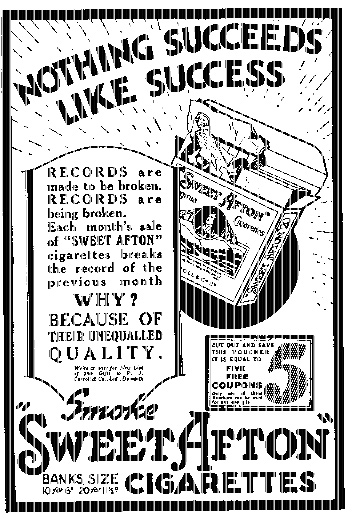
Advertising agencies
These were charges that continued to be levelled at Irish industrialists throughout the period under review and after, but as they related specifically to commercial design and publicity it must be remembered that advertising services as they now exist were in their infancy. Though Wilson Hartnell and Company had been established in Dublin in 1879 its role was more that of a press agency, and it was not until Kevin J. Kenny, who had served as Moran’s business manager, set up his Multum in Parvo advertising agency in Amiens Street in the first decade of the new century that the elements of a ‘creative’ advertising service began to be provided. Before this it was left to the manufacturer or vendor himself, or to the publication in which he was advertising, to supply design and copy. ‘Like that, see’, Leopold Bloom explained to Mr Nanneti of The Freeman in James Joyce’s Ulysses, ‘two crossed keys here. A circle. Then here the name Alexander Keyes, tea, wine and spirit merchant. So on. It’s a play on the name’, Bloom explained to the unimpressed newspaperman, and the pun, verbal and visual, was to remain a significant element of brand identity until fashion in the modern era dictated a return to the manufacturer’s or designer’s name pure and simple, having persuaded otherwise intelligent people in the meantime to walk the streets as free advertising vehicles for ‘designer labels’. The infancy of branding, however, saw such portmanteau names as Willwood (Williams and Woods’ preserves) and O’Dearest (O’Dea & Co., mattresses) and the use of simple initials as in LCF (Limerick Clothing Factory) and C & C (Cantrell and Cochrane mineral waters). Acronyms included Mi-Wadi (Mineral Water Distributors’ soft drinks) and GYE (Guinness Yeast Extract, a cousin of the Australian Vegemite). Few of these verbal stratagems could be said to exhibit any marked Irish identity, only the sizeable range of products named simply after their place of production clearly proclaiming their origin. Amongst these were Balbriggan hosiery—a name which in the nineteenth century had achieved the status of a common noun; Tullamore Dew and Bushmills (whiskey); Dripsey and Blarney (tweeds) and many others.
Familiar stereotypes
Producing as they were largely for a restricted home market, few manufacturers saw the necessity or desirability of attempting to create a national brand image, and those that did looked little further than familiar stereotypes, both visual and verbal. Amongst these the long-suffering national emblem found itself incorporated in the logos of many commercial Shamrock brands, while out of the same conventional stable came Emerald household flour (Johnston, Mooney & O’Brien); National Brand underwear; New Ireland Insurance; The Gaelic Brush (I.S. Varian & Co.); Gaelite Signs (neon signs) and Irel coffee essence (Johnson Brothers). The latter was launched in 1913; three years later, in The Irish Homestead of 23 December, Æ was considering the question of ‘the Christening of Irish cheeses’:
We must say that we do not like the idea of calling a cheese made in Ireland ‘Irish cheddar’, any more than we would like to see butter sold in the markets as Siberian Irish, or foreign tobacco rolled up and sold as Turkish ‘Banba’ cigarettes….In our opinion it would be much better to have the Irish trade mark on what we produce from the very start.
He was to return to the theme in 1923 in the context of the newly independent Ireland in the matter of a national brand for butter as recommended in the interim report of the Commission on Agriculture.
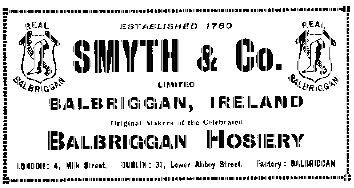
With the establishment of native government in 1921 the whole industrial situation had altered. No machinery to deal with industrial development had existed under the British regime, and one of the first steps of the new administration was to establish advisory committees for each major industry. But industry as a whole was providing employment for only 100,000 people. This represented no more than seven per cent of the available labour force, and it was clear that drastic new measures would be required. The first major impetus was provided by the establishment of the Electricity Supply Board in 1927 and the subsequent inauguration of the Shannon hydro-electric scheme. Nevertheless, in spite of the introduction of available power and new industries such as beet growing designed to expand the industrial base, new jobs created between 1926 and 1931 totalled no more than 5,000.
Protectionism
In 1932 a Fianna Fáil government replaced the Cumann na nGaedheal administration which had held power since independence, and the slow shift towards the introduction of tariffs on imported goods which had already been taking place became a policy-driven reality with the appointment of Sean Lemass as Minister for Industry and Commerce. A protectionist lobby which had existed since the early 1920s had resulted in the formation of the National Agricultural and Industrial Development Association, but the business community, particularly those with a vested interest in trade with Britain, were largely opposed to it. The new administration, however, moved decisively, advocating import substitution and establishing, in May 1932, an Industrial Development branch within the Department of Industry and Commerce. The creation of the Industrial Credit Company and the consequent expansion of loan facilities resulted in over a thousand new joint stock companies being registered between 1932 and 1938. At the same time new state-sponsored enterprises were being set up in areas such as air transport, peat fuel and sugar production and fisheries.
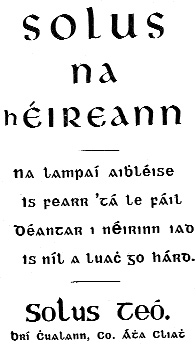
The new industrial bourgeoisie which came into being as a result of these policies quickly realised where their interests lay. ‘To describe them as entrepreneurs would be too strong’, in the view of Brian Girvin in Between Two Worlds (1989), ‘for they demanded protection from all external competition. They owed their position to the state, and rather than develop an industry capable of competition, they lobbied the state to enforce this effective monopoly.’ In practical terms many were content to produce imitations of familiar British products and also to ape them in the matter of brand identity. Thus TD Sauce (i.e. Teachta Dála, or Member of Parliament) appeared as the native equivalent of HP Sauce (Houses of Parliament) whilst British concerns such as the Imperial Tobacco Company, which had been obliged under the Control of Manufactures Acts to set up Irish subsidiaries or lose the market, were content to sell their wares under their established brand names.
The Irish language in advertising
The early nineteenth-century nationalist movement had expressed little concern for the future of the Irish language: only Thomas Davis was a positive advocate of its preservation, while O’Connell had actively encouraged its replacement by English as the medium of everyday communication. Though specialised bodies, such as the Hiberno-Celtic Society (1818) and the Irish Archaeological Society (1840) were established to study and preserve both the historical and literary heritage, the focus was largely academic, and it was not until the foundation of the Gaelic League in 1893 that the revival movement really entered the public domain.
By then, of course, Irish had ceased to be the language of the streets and the market for the large majority of the people, so it is scarcely surprising that the move to restore it evoked little response in commercial circles. Members of the Yeats family traded under the names of Dún Emer (crafts) and Cuala (printing and publishing), but these were what would now be stigmatised as elitist products: on the more basic level examples were few. A whiskey label bore the bilingual legend Locke’s Kilbeggan Uisce Beatha Irish Whiskey, but few firms were prepared to risk branding in the Irish language alone unless a name could be considered phonetically accessible to non-Irish speakers, as in the case of Solus (light bulbs). A compromise solution was Anglicisation, as exemplified by Smyth & Co’s Coulin whiskey (Ir. cuileann, fair maiden) and by Irish Ropes Ltd., which produced sisal carpeting under the name Tintawn (Ir. tinteán, hearth) in the belief that even those with minimal Irish would associate it with the proverb Níl aon tinteán mar do thinteán féin (There’s no hearth like one’s own hearth). Such anglicisation, together with brands such as Erin, Banba, and others from the national pantheon, were frequently supported by what was to become the hackneyed imagery of shamrocks, round towers, wolfhounds and sunburstery. Stage-Irishisms, such as Colleen soap, were also resorted to; though Paddy Whiskey, on the face of it the most blatant example, actually began life as Paddy Flaherty, capitalising on the popularity of one of the company’s salesmen.
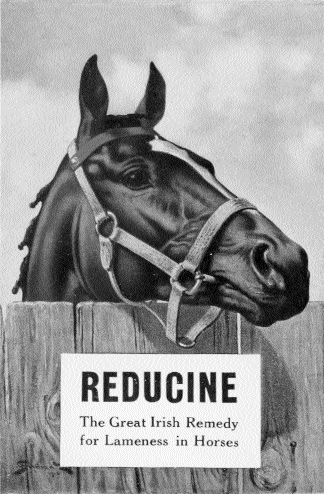
Semi-state bodies
The establishment in the 1930s of the many semi-state bodies, legally required to implement in the matter of nomenclature a bilingual policy, opened new possibilities for Irish branding. Whilst the Electricity Supply Board was never popularly identified under its Irish title of Bord Soláthair an Leictrachais (nor the Gaelic Athletic Association, rather more surprisingly, as Cumann Luthchleas Gael), the organisation which began life as Irish Sea Airways in 1936 became Aer Lingus—an Anglicisation by the Cork County Surveyor Richard O’Connor of Aer Loingeas, or ‘air fleet’ (cf. Aeroflot) and several other new names passed fairly easily into the dominantly anglophone public domain, including Bord na Móna, the peat development authority; Fógra Fáilte, the tourist board, ancestor of Bord Fáilte and Raidio Éireann, generally part-anglicised to ‘Radio’. Few of these new bodies, however, carried an Irish nomenclature policy into the market-place, Bord na Móna’s Lullymore Briquettes, for example, opting for the safe identity of the point of production.
World War II (which acquired its own Irish branding as ‘The Emergency’) was to spawn a number of products produced to fill the gaps created by the virtual cessation of British imports (Blitz washing powder, Abbey Tan leg makeup in lieu of stockings) but by then the Irish-Ireland ideal, in its commercial context, was losing much of its impetus and the post-war world was to see the emergence of brand identity creation as a highly sophisticated—and expensive—pseudo-science. It is perhaps a source of quiet satisfaction that some of the names which evolved in the enthusiastic but naive circumstances of the industrial revival’s early years should still be with us today.
Bernard Share is a writer in the fields of language and social history.
Further reading:
H. Oram, The Advertising Book (Dublin 1986).
M. E. Daly, Industrial Development and Irish National Identity 1922-1939 (New York 1992).
















